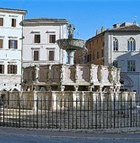The Silvestrine monk Fra Bevignate was probably born in Cingoli.
Perugia (1277 - 1306)
Fra Bevignate was first documented in Perugia in 1277, and was prominent in the affairs of the city until his death some thirty years later. He was the Director of Works for the city for most of this time, and he also played a prominent role as a diplomat and civic administrator.
Fra Bevignate is best remembered for his role in the construction of the Fontana Maggiore at Perugia (see below) in 1277-8. His intervention marks the end of what had been a tortuous process, and the start of a rapid and efficient construction phase.
When Pope Martin IV was driven from Orvieto by the Ghibelline resurgence there in 1284, he moved to Perugia (newly reconciled with him after its defiance in the matter of war with Foligno). The Commune appointed Fra Bevignate to oversee the adaptation of Palazzo dei Canonici the adjacent Palazzo del Podestà to form a new papal palace
When Martin IV died in Perugia in 1285, he became the third pope to be interred in the Duomo. In 1287, the College of Cardinals asked the Commune to appoint Fra. Bevignate to oversee the construction of his funerary monument. It is possible that statues of SS Laurence and Herculanus that now decorate the pulpits of the Duomo came from his original monument. During later reconstruction, all three papal monuments were destroyed and the bodies of the three popes were placed in an iron cask.
Fra. Bevignate was associated with the construction of the new Duomo of Orvieto in 1291-1300 (see below). It was probably because of this that he was appointed to supervise the reconstruction of the Duomo of Perugia in 1300, although it is not clear how much of the surviving structure can be attributed to him.
Fra’ Bevignate buttressed the retaining wall of Piazza Sopramuro (now Piazza Matteotti - see Walk II) in the late 13th century, so that it supported a paved terrace, the so-called Campo di Battaglia, some way below the level of the street. This space took its name from the Battaglia dei Sassi (Battle of the Stones), an annual stone-throwing contests between representatives of the five districts of Perugia.
The Commune confirmed his position as Director "di ogni impresa" (of all works) underway in the city in 1305, but he seems to have died shortly afterwards.
Fontana Maggiore (1277-8)
The Commune first began to plan the construction of a new aqueduct to bring water to the city from Montepacciano in 1254. The work made little headway until 1277, when a commission of enquiry advised that it should be executed by the Venetian hydraulic engineer, Boninsegna. The Commune accepted this advice, and the work was soon completed.

In 1277, Fra. Bevignate suggested the appointment of Arnolfo di Cambio for the sculpture on the fountain, and the Commune sought permission of King Charles d’ Anjou for his release from work in Rome. However, it seems that this could not be arranged in time, and the work was given to the father and son Nicola and Giovanni Pisani.
Fra. Bevignate is commemorated in two inscriptions on the fountain:
-
✴The upper basin is cast in bronze and carries an inscription that translates: "Rubeus made (i.e. cast) me in 1277, at the time of Podestà Geraldino dei Boschetti and Capitano del Popolo Anselmo di Alzate. Those responsible for the work were the Benedictine Fra. Bevignate and Boninsegna".
-
✴The middle basin carries a long inscription which includes the following: “City of Perugia, rejoice and remember as your father good Fra. Bevignate, devoted to every wise undertaking. He is the builder of this work, he directed all things. We should praise him with the sweet name of [St] Benedict. Capable of order, he has given us this work and is pleased.” It also commemorates the sculptors Nicola and Giovanni Pisani and the engineer Boninsegna, and it records the completion of the work in 1278, at the time of Pope Nicholas III and the Emperor Rudolf I.
Gubbio (late 12th century)
San Francesco (1259-92)
Local tradition attributes the construction of San Francesco to Fr. Bevignate, although there is no documentary support for this hypothesis.
Orvieto
Duomo (1291-1300)
Fra. Bevignate is documented in Orvieto in 1291, although the nature of his work there is unspecified. Since Pope Nicholas IV (who had been a member of the College of Cardinals at the time of the commission of the monument of Pope Martin IV in Perugia) had laid the foundation stone of the Duomo of Orvieto in the previous year, it seems likely that Fra. Bevignate had been called to the city to initiate the construction project. He had certainly acted as "operarius” (probably overall supervisor) on the project before 1295, the year in which he was reconfirmed in this post, and another confirmation followed in 1300. He seems to have been responsible for the initial design, the construction of the nave and the bottom order of the facade.



